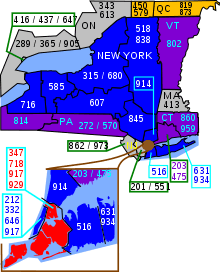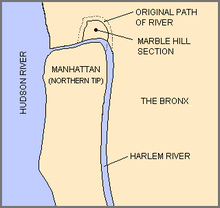Area codes 718, 347, and 929
Area codes 718, 347, and 929 are telephone area codes in the North American Numbering Plan (NANP) for the boroughs of New York City of the Bronx, Brooklyn, Queens, and Staten Island, as well as the Marble Hill section of Manhattan. They are part of a larger overlay plan with area code 917, which comprises all of New York City.

History
For the first 37 years after the establishment of the North American Numbering Plan in 1947, all of New York City was a single numbering plan area (NPA), area code 212. In 1984, New York Telephone asked the New York Public Service Commission to split part of New York City into a new area code to "prevent an impending exhaustion of telephone numbers."[1] On February 1, 1984, the commission voted to split serve Brooklyn, Queens, and Staten Island into a new area code, with Manhattan and the Bronx retaining 212. The announcement of the impending split triggered protests and threats of legal action from local officials and lawmakers representing the outer boroughs. Despite this, New York Telephone implemented the new 718 area code on September 1, 1984. The split was implemented in a way that split the city's three million telephone numbers roughly in half. Permissive dialing of 212 continued across New York City until January 1, 1985.[1]
On July 1, 1992, the Bronx and the neighborhood of Marble Hill, Manhattan were also split from numbering plan area 212, and were added to 718. A permissive dialing period for using either area code 212 or 718 in the affected area lasted until May 16, 1993.[2][3]
On October 1, 1999, area code 347 was added as an overlay code to area code 718.
On December 16, 2009, the New York Public Service Commission approved an additional overlay code for the 718/347 numbering plan area.[4] On January 22, 2010, NeuStar announced another overlay code (929) for the New York City 718 and 347 area codes of boroughs outside Manhattan.[5][6] Area code 929 became effective on April 16, 2011.[7] This had the effect of assigning 23.4 million numbers to an area of 6.7 million people.
In 2018, NPA 347/718/929 had a projected exhaustion date of 2029.[8] As of April 2020, the time until exhaustion has been reduced by two years to 2027.[9]
Area code 917 overlays area codes 718, 347, and 929, as well as area codes 212, 646 and 332 in Manhattan.
Marble Hill

Despite being legally a part of the borough of Manhattan,[10] per the Greater New York Charter of 1897, the neighborhood Marble Hill is excluded from the Manhattan numbering plan areas 212, 646, and 332, but uses 718, 347, or 929 area codes.[10] It used to be attached to Manhattan Island.[10] After the Harlem River Ship Canal was built in 1895, Marble Hill was separated from Manhattan Island by water.[11] Soon after, the Spuyten Duyvil Creek was filled in with landfill, physically connecting Marble Hill to the Bronx.[10]
When the 718 numbering plan area was extended to the Bronx, Marble Hill residents unsuccessfully fought to retain area code 212.[10] Marble Hill receives its dialtone from the Bronx central offices, and it would have been too expensive for New York Telephone to reroute Marble Hill's trunk so it could remain in 212.
In popular culture
The 718 area code was celebrated in the 1998 2 Skinnee J's song "718", in which the rappers tell of people moving from Manhattan (212) to other boroughs (718) for lower rent.[12]
Hip-hop group Theodore Unit (which includes Wu-Tang Clan member Ghostface Killah) released an album entitled 718, an homage to their home of Staten Island, which is contained within the 718 area code. Rapper/actor Mos Def refers to the 718 area code in his song "Sunshine", and in M.O.P.'s song "Ante Up", they mention "repping 1–718 dangerously".
"718" is a track produced by DJ Premier from Jaz-O & Immobilarie album Kingz Kounty.
The area code was briefly mentioned in the song "Don't Be One", which is part of the Felony album by American metalcore band Emmure.
The mixtape Return of the PLK contains the song titled "718 Nigga" by Rapper Lloyd Banks.
The FannyPack album See You Next Tuesday contains the song "Seven One Eight". This song was featured in the Don't Trust the B---- in Apartment 23 episode "Paris...".
The area code was mentioned as part of Barney Stinson's citation of many New York area codes in the How I Met Your Mother episode "No Tomorrow".
On the episode of Seinfeld entitled "The Maid," Elaine says that she used to be "a 718" which made her "cry every night".
"718" was referred to in the "Salon of the Dead" episode of Gossip Girl as the "slums".
Included in the 2001 song "Area Codes" as one of the many locations where rapper Ludacris has "hoes".[13]
A number from the +1-347 area code appears as "Come forth and call 489-4608, and I'll be here"[14] in the lyrics of "Diary", a track on album The Diary of Alicia Keys.[15]
In Sex and the City, when Carrie returns from Mexico and her personal assistant Louise procures a new cell phone number, Louise begins to tell Carrie her new phone number, beginning with the 347 area code. Carrie interrupts insisting she's a "917 girl," to which Louise responds, "Now you're a 347 girl."
The runner-up (but dastardly) dance group in the 2011 movie Honey 2 is called "718".
See also
- List of New York area codes
- List of NANP area codes
- North American Numbering Plan
References
- Barbanel, Josh (February 16, 1984). "718 Area Code for Brooklyn, Queens and Staten Island Gains Approval". The New York Times. Retrieved September 26, 2017.
- http://www.nanpa.com/pdf/old_pl/IL%2091-08-001.pdf
- http://www.ny1.com/nyc/bronx/bronx-week-2015/2015/06/12/what-s-in-a-name--while-marble-hill-s-origins-are-clear--its-present-status-is-up-for-debate.html
- "PSC Approves New Area Code for NYC Outer Boroughs" (PDF). 3.dps.ny.gov. Retrieved May 19, 2016.
- "Additional Area Code Planned for New York City “929” Overlay Code Assigned to Outer Boroughs". Neustar. January 22, 2010.
- "Additional Area Code Planned for New York City". Prnewswire.com. January 22, 2010. Retrieved May 19, 2016.
- Newman, Andy. "Say Hello to 929". The New York Times. April 15, 2011.
- 2018 October NANPA Exhaust Projections
- 2020 April NANPA Exhaust Projections
- Bloom, Jennifer Kingson. "A Bit of Manhattan In the Bronx: A little-known enclave in a spot where the Bronx should be.". The New York Times. July 23, 1995.
- "What's in a Name: While Marble Hill's Origins Are Clear, Its Present Status is Up for Debate". New York 1 News. Retrieved June 18, 2015.
- "718 Lyrics - 2 Skinnee J's". Lyricsbox.com. Retrieved May 19, 2016.
- "Ludacris – Area Codes Lyrics | MetroLyrics". Metrolyrics.com. Retrieved July 17, 2015.
- "Alicia Keys fans: Right number, wrong person". USA Today. August 10, 2004.
- "Dear Diary". snopes.com. Retrieved May 15, 2016.
| New York area codes: 212/332/646, 315/680, 347/718/929, 516, 518/838, 585, 607, 631/934, 716, 845, 914, 917 | ||
|---|---|---|
| North: 914, 845, 203/475 | ||
| West: 212/646/332/917, 201/551, 908, 862/973 | area code 347/718/929, overlaid by 917 | East: 516, 631/934 |
| South: 212/646/332/917, 732/848, Atlantic Ocean | ||
| New Jersey area codes: 201/551, 609/640, 732/848, 856, 862/973, 908 | ||
| Connecticut area codes: 203/475, 860/959 | ||